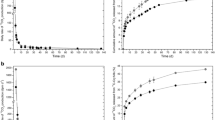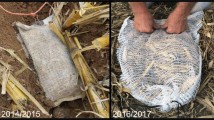Abstract
Cultivation of genetically modified maize (Bt-maize; event MON810) producing recombinant δ-endotoxin Cry1Ab, leads to introduction of the insecticidal toxin into soil by way of root exudates and plant residues. This study investigated the fate of Cry1Ab in soil under long-term Bt-maize cultivation in an experimental field trial performed over nine growing seasons on four South German field sites cultivated with MON810 and its near isogenic non Bt-maize variety. Cry1Ab protein was quantified in soil (<2 mm size) using an in-house validated ELISA method. The assay was validated according to the criteria specified in European Commission Decision 2002/657/EC. The assay enabled quantification of Cry1Ab protein at a decision limit (CCα) of 2.0 ng Cry1Ab protein g−1 soil with analytical recovery in the range 49.1–88.9%, which was strongly correlated with clay content. Cry1Ab protein was only detected on one field site at concentrations higher than the CCα, with 2.91 and 2.57 ng Cry1Ab protein g−1 soil in top and lower soil samples collected 6 weeks after the eighth growing season. Cry1Ab protein was never detected in soil sampled in the spring before the next farming season at any of the four experimental sites. No experimental evidence for accumulation or persistence of Cry1Ab protein in different soils under long-term Bt-maize cultivation can be drawn from this field study.


Similar content being viewed by others
References
Badea EM, Chelu F, Lacatusu A (2010) Results regarding the levels of Cry1Ab protein in transgenic corn tissue (MON810) and the fate of Bt protein in three soil types. Rom Biotech Let 15(1):55–62
Baumgarte S, Tebbe CC (2005) Field studies on the environmental fate of the Cry1Ab Bt toxin produced by transgenic maize (MON810) and its effect on the bacterial communities in the maize rhizosphere. Mol Ecol1 4:2539–2551
Bayerische Landesanstalt für Landwirtschaft (2005) Monitoring der Umweltwirkungen des Bt-Gens Forschungsprojekt im Auftrag des Bayerischen Staatsministeriums für Umwelt, Gesundheit und Verbraucherschutz. LfL-Schriftenreihe ISSN 1611–4159 (7)
Byrne D (2002) Commission decision of 12 August (2002) Implementing the council directive 96/23/EC concerning the performance of analytical methods and the interpretation of results (2002/657/EC). Off J Eur Commun L221:8–33
CERA (2010) GM crop database. Center for environmental risk assessment (CERA), ILSI research foundation, Washington, DC. http://www.cera-gmc.org/index.php?action=gm_crop_database
Chevallier T, Muchaonyerwa P, Chenu C (2003) Microbial utilisation of two proteins adsorbed to a vertisol clay fraction: toxin from Bacillus thuringiensis subsp tenebrionis and bovine serum albumin. Soil Biol Biochem 35:1211–1218
Clark BW, Phillips TA, Coats JR (2005) Environmental fate and effects of Bacillus thuringiensis (Bt) proteins from transgenic crops: a review. J Agric Food Chem 53(12):4643–4653
Crecchio C, Stotzky G (1998) Insecticidal activity and biodegradation of the toxin from Bacillus thuringiensis subsp. kurstaki bound to humic acids from soil. Soil Biol Biochem 30(4):463–470
Crecchio C, Stotzky G (2001) Biodegradation and insecticidal activity of the toxin from Bacillus thuringiensis subsp kurstaki bound on complexes of montmorillonite—humic acids—Al hydroxypolymers. Soil Biol Biochem 33(4–5):573–581
Crickmore N, Zeigler DR, Feitelson J, Schnepf E, Van Rie J, Lereclus D, Baum J, Dean DH (1998) Revision of the nomenclature for the Bacillus thuringiensis pesticidal crystal proteins. Microbiol Mol Biol Rev 62(3):807–813
Ferré J, Van Rie J (2002) Biochemistry and genetics of insect resistance to Bacillus thuringiensis. Ann Rev Entomol 47:501–533
Gruber H, Paul V, Meyer HHD, Müller M (2008) Validation of an enzyme immunoassay for monitoring Cry1Ab toxin in soils planted with Bt-maize (MON810) in a long-term field trial on four South German sites. J Cons Prot Food Saf 3:22–25
Guertler P, Paul V, Albrecht C, Meyer HHD (2009) Sensitive and highly specific quantitative real-time PCR and ELISA for recording a potential transfer of novel DNA and Cry1Ab protein from feed into bovine milk. Anal Bioanal Chem 393:1629–1638
Guertler P, Paul V, Steinke K, Wiedeman S, Preißinger W, Albrecht C, Spiekers H, Schwarz FJ, Meyer HHD (2010) Long-term feeding of genetically modified corn (MON810)—fate of cry1Ab DNA and recombinant protein during the metabolism of the dairy cow. Livest Sci 131:250–259
Harwood JD, Samson RA, Obrycki JJ (2006) No evidence for the uptake of Cry1Ab Bt-endotoxins by the generalist predator Scarites subterraneus (Coleoptera: Carabidae) in laboratory and field experiments. Biocontrol Sci Technol 16(4):377–388
Head G, Surber JB, Watson JA, Martin JW, Duan JJ (2002) No detection of Cry1Ac protein in soil after multiple years of transgenic Bt cotton (bollgard) use. Environ Entomol 31:30–36
Hilbeck A, Moar WJ, Pusztai-Carey M, Filippini A, Bigler F (1999) Prey-mediated effects of Cry1Ab toxin and protoxin and Cry2A protoxin on the predator Chrysoperla carnea. Entomol Exp Appl 91:305–316
Hoefte H, Whiteley HR (1989) Insecticidal crystal proteins of Bacillus thuringiensis. Microbiol Rev 53:242–255
Hoess S, Arndt M, Baumgarte S, Tebbe C, Nguyen-Thu H, Jehle J (2008) Effects of transgenic corn and Cry1Ab protein on the nematode, Caenorhabditis elegans. Ecotox Environ Saf 70:334–340
Hopkins D, Gregorich EG (2003) Detection and decay of the Bt endotoxin in soil from a field trial with genetically modified maize. Eur J Soil Sci 54:793–800
Icoz I, Stotzky G (2008) Fate and effects of insect-resistant Bt crops in soil ecosystems. Soil Biol Biochem 40:559–586
Kaiser-Alexnat R, Meise T, Langenbruch G, Hommel B, Huber J (2005) Studies on the early detection of resistance development of the European corn borer (Ostrinia nubilalis) to the Bt-corn-toxin Cry1Ab. Nachrichtenblatt Deut Pflanzenschutzd 57:144–151
Koskella J, Stotzky G (1997) Microbial utilization of free and clay-bound insecticidal toxins from Bacillus thuringiensis and their retention of insecticidal activity after incubation with microbes. Appl Environ Microbiol 63(9):3561–3568
Koziel MG, Beland GL, Bowman C, Carozzi NB, Crenshaw R, Crossland L, Dawson J, Desai N, Hill M, Kadwell S, Launis K, Lewis K, Maddox D, McPherson K, Meghji MR, Merlin E, Rhodes R, Warren GW, Wright M, Evola SV (1993) Field performance of elite transgenic maize plants expressing an insecticidal protein derived from Bacillus thuringiensis. Nat Biotech 11:194–200
Losey JE, Rayor LS, Carter ME (1999) Transgenic pollen harms monarch butterflies. Nature 399:214
Marvier M, McCreedy C, Regetz J, Kareiva P (2007) A meta-analysis of effects of Bt cotton and maize on nontarget invertebrates. Science 316(5830):1475–1477
Meissle M, Romeis J (2009) Insecticidal activity of Cry3Bb1 expressed in Bt-maize on larvae of the Colorado potato beetle, Leptinotarsa decemlineata. Entomol Exp Appl 131:308–319
Mendelsohn M, Kough J, Vaituzis Z, Matthews K (2003) Are Bt crops safe? Nat Biotechnol 21:1003–1009
Nguyen HT, Jehle JA (2007) Quantitative analysis of the seasonal and tissue-specific expression of Cry1Ab in transgenic maize Mon810. J Plant Dis Prot 114:82–87
Pagel-Wieder S, Gessler F, Niemeyer J, Schröder D (2004) Adsorption of the Bacillus thuringiensis toxin (cry1Ab) on Na-montmorillonite and on the clay fractions of different soils. J Plant Nutr Soil Sci 167:184–188
Pagel-Wieder S, Niemeyer J, Fischer WR, Gessler F (2007) Effects of physical and chemical properties of soils and adsorption of the insecticidal protein (Cry1Ab) from Bacillus thuringiensis at Cry1Ab protein concentrations relevant for experimental field sites. Soil Biol Biochem 39(12):3034–3042
Palm C, Donegan H, Harris D, Seidler R (1994) Quantification in soil of Bacillus thuringiensis var kurstaki delta-endotoxin from transgenic plants. Mol Ecol 3:145–151
Paul V, Steinke K, Meyer HHD (2008) Development and validation of a sensitive enzyme immunoassay for surveillance of Cry1Ab toxin in bovine blood plasma of cows fed Bt-maize (MON810). Anal Chim Acta 607:106–113
Paul V, Guertler P, Wiedemann S, Meyer HHD (2010) Degradation of Cry1Ab protein from genetically modified maize (MON810) in relation to dietary feed proteins in dairy cow digestion. Transgenic Res 19(4):683–689
Priestley AL, Brownbridge M (2009) Field trials to evaluate effects of Bt-transgenic silage corn expressing the Cry1Ab insecticidal toxin on non-target soil arthropods in northern New England, USA. Transgenic Res 18(3):425–443
Rauschen S, Schuphan I (2006) Fate of the Cry1Ab protein from Bt-maize MON810 silage in biogas production facilities. J Agric Food Chem 54(3):879–883
Roush RT (1997) Bt-transgenic crops: just another pretty insecticide or a chance for a new start in resistance management? Pestic Sci 51(3):328–334
Saeglitz C, Bartsch D, Eber S, Gathmann A, Priesnitz KU, Schuphan I (2006) Monitoring the Cry1Ab susceptibility of European Corn Borer in Germany. J Econ Entomol 99(5):1768–1773
Saxena D, Stotzky G (2000) Insecticidal toxin from Bacillus thuringiensis is released from roots of transgenic Bt corn in vitro and in situ. FEMS Microbiol Ecol 33(1):35–39
Saxena D, Stotzky G (2001) Bacillus thuringiensis (Bt) toxin released from root exudates and biomass of Bt corn has no apparent effect on earthworms, nematodes, protozoa, bacteria, and fungi in soil. Soil Biol Biochem 33(9):1225–1230
Saxena D, Stotzky G (2003) Fate and effects in soil of the insecticidal toxins from Bacillus thuringiensis in transgenic plants. Coll Biosaf Rev 1:9–85
Saxena D, Flores S, Stotzky G (2002) Vertical movement in soil of insecticidal Cry1Ab protein from Bacillus thuringiensis. Soil Biol Biochem 34:111–120
Schnepf E, Crickmore N, Van Rie J (1998) Bacillus thuringiensis and its pesticidal crystal proteins. Microbiol Mol Biol Rev 62:775–806
Stotzky G (2000) Persistence and biological activity in soil of insecticidal proteins from Bacillus thuringiensis and of bacterial DNA bound on clays and humic acids. J Environ Qual 29:691–705
Stotzky G (2002) Clays and humic acids affect the persistence and biological activity of insecticidal proteins from Bacillus thuringiensis in soil. Dev Soil Sci 28(2):1–16
Stotzky G (2005) Persistence and biological activity in soil of the insecticidal proteins from Bacillus thuringiensis, especially from transgenic plants. Plant Soil 266(1–2):77–89
Tabashnik BE, Liu Y-B, Finson N, Masson L, Heckel DG (1997) One gene in diamondback moth confers resistance to four Bacillus thuringiensis toxins. Proc Natl Acad Sci 94(5):1640–1644
Tapp H, Stotzky G (1995) Insecticidal activity of the toxins from Bacillus thuringiensis subspecies kurstaki and tenebrionis adsorbed and bound on pure and soil clays. Appl Environ Microbiol 61(5):1786–1790
Tapp H, Stotzky G (1998) Persistence of the insecticidal toxin from Bacillus thuringiensis subsp kurstaki in soil. Soil Biol Biochem 30:471–476
Tapp H, Calamai L, Stotzky G (1994) Adsorption and binding of the insecticidal proteins from Bacillus thuringiensis subsp kurstaki and subsp tenebrionis on clay minerals. Soil Biol Biochem 26:663–679
US Environmental Protection Agency Office of Pesticide Programs (2001) Biopesticides Registration Action Documents Bacillus thuringiensis Plant-Incorporated Protectants. http://www.epa.gov/pesticides/biopesticides/pips/bt_brad2/3-ecological.pdf
Van Rie J, Jansens S, Höfte H, Degheele D, Van Mellaert H (1990) Receptors on the brush border membrane of the insect midgut as determinants of the specificity of Bacillus thuringiensis delta-endotoxins. Appl Environ Microbiol 56(5):1378–1385
Wang H, Ye Q, Wang W, Wu L, Wu W (2006) Cry1Ab protein from Bt transgenic rice does not residue in rhizosphere soil. Environ Pollut 143:449–455
Acknowledgments
The research project was supported by the State of Bavaria. We thank the staff at the Bavarian experimental stations Baumannshof, Puch, Neuhof, and Grub for their engaged contribution to this work. We gratefully acknowledge the excellent technical assistance of S. Gellan and helpful support by U. Ziegltrum and J. Karpf. We are very thankful for the contributions of R. Brandhuber from the Institute for Agricultural Ecology, Organic Farming and Soil Protection (Bavarian State Research Center for Agriculture) and from J. Kler, who performed the soil-texture analysis.
Author information
Authors and Affiliations
Corresponding author
Rights and permissions
About this article
Cite this article
Gruber, H., Paul, V., Meyer, H.H.D. et al. Determination of insecticidal Cry1Ab protein in soil collected in the final growing seasons of a nine-year field trial of Bt-maize MON810. Transgenic Res 21, 77–88 (2012). https://doi.org/10.1007/s11248-011-9509-7
Received:
Accepted:
Published:
Issue Date:
DOI: https://doi.org/10.1007/s11248-011-9509-7




